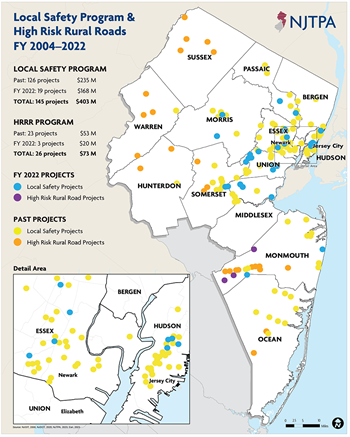Local Safety Program/High Risk Rural Roads
 |
| Click map to enlarge |
The NJTPA works with its federal partners, the New Jersey Department of Transportation (NJDOT), subregions and other state and local agencies to make travel safer and more reliable for everyone who uses our region’s transportation system. To support these efforts, the NJTPA solicits candidate projects for implementation under two safety funding programs every other fiscal year, the Local Safety and High Risk Rural Roads programs. These programs, which fund cost-effective solutions that can make an immediate impact on their target areas, are described below.
Local Safety Program
This federally-funded program is a component of wider safety planning at the NJTPA, supporting construction of cost-effective, high-impact safety improvements on county and local roadway facilities in the NJTPA region. Projects on State, U.S. and Interstate highways are not eligible for funding under this program.
Since its inception with a pilot program in 2004, the NJTPA has allocated $340 million in Highway Safety Improvement Program (HSIP) funds for 144 projects. Typical projects supported by this program include new and upgraded traffic signals, road diets, modern roundabouts, pedestrian safety including countdown signal heads, high visibility crosswalks, curb extensions, new and upgraded signs and pavements markings, bike lanes and other improvements New Jersey is a focus state for Pedestrian and Bicycle Safety and Intersection Safety.
High Risk Rural Roads
This program using federal funding that has specifically been set aside to address safety needs in rural areas. Since its inception in 2009, this program has allocated more than $60 million for 26 projects (click on this link for more information on these projects). Typical projects supported by this program include high friction surface treatment and mircosurfacing, correction of curve superelevations, centerline and edgeline rumble strips, upgraded pavement markings and signs. Roadway departures account for about half of all the traffic fatalities in the United States.
Consultant Assistance
The Consultant Assistance Program aids subregions with preparing applications in advance of a solicitation for the Local Safety (LSP) and High Risk Rural Roads (HRRRP) programs. It is not a pre-requisite to apply for either the LSP or HRRRP.
The consultant begins assisting our Subregions a year in advance of the solicitation for the Safety programs. Consultants help with traffic data collection, crash diagrams, environmental impacts, alternative analysis, conceptual layouts and the HSM analysis. These studies and analyses are required portions of the application.
Strategic Highway Safety Plan Data Viewer
This tool (link here) combines data from other sources in a map format that aids in crash analysis and project development for all three MPO regions in New Jersey. Data includes fatal and serious injury crashes, high-crash locations and corridors, Federal Highway Administration - Highway Safety Improvement Program (HSIP) funded projects, Road Safety Audits, and Environmental Justice communities. Click on the link to open the data viewer and the user guide for instructions. The user guide is available here.
Vulnerable User (VU) and Vehicle Traffic Counts Viewer
This viewer (link here) serves as a compendium of traffic counts collected by the NJTPA. The focus is on vulnerable user counts (pedestrian, cyclists and micromobility users), though many vehicular-focused counts are also available. The count data includes counts collected during NJTPA projects and any counts subregional partners have shared with the NJTPA. For more detailed information, including data in 15-minute bins and counts categorized by user type, please contact NJTPA staff. The database includes a glossary and a an “About” section for more information, including potential use cases and variations within the data. The database was produced as a recommendation from the Pedestrian Counts Project completed in June 2022.
For further information on these NJTPA programs contact:
Christine Mittman
Project Manager, Safety Programs
973-639-8448
[email protected]
Sascha Frimpong
Director, Local Programs and Project Development
973-639-8422
[email protected]